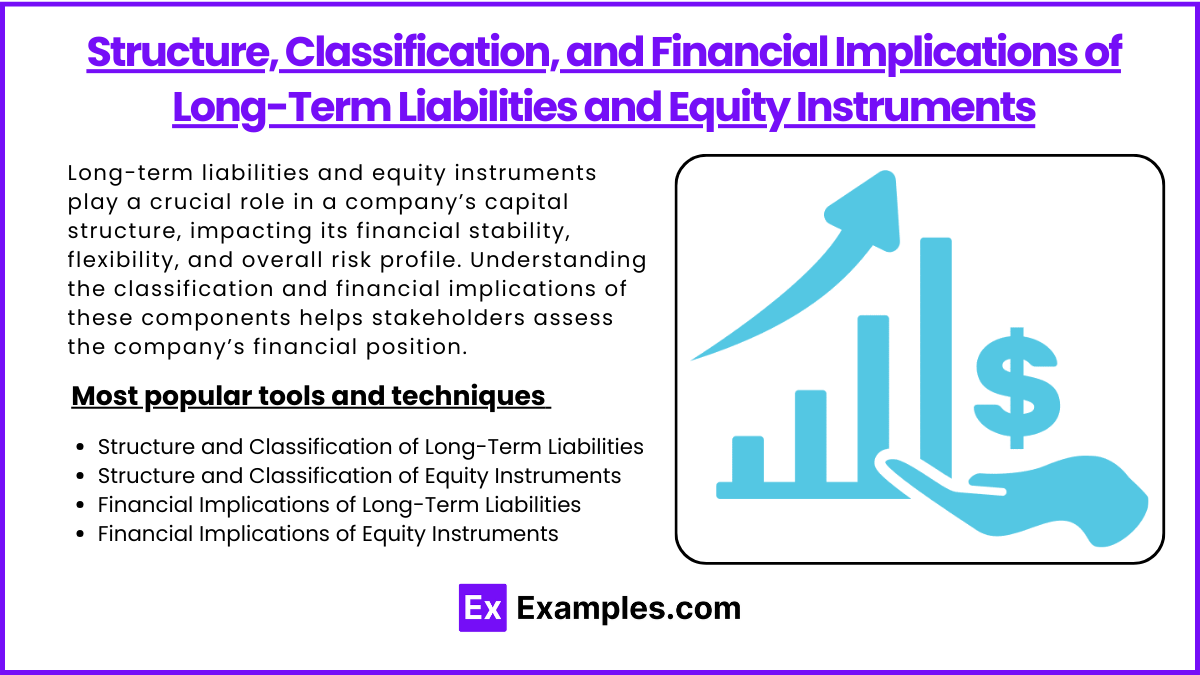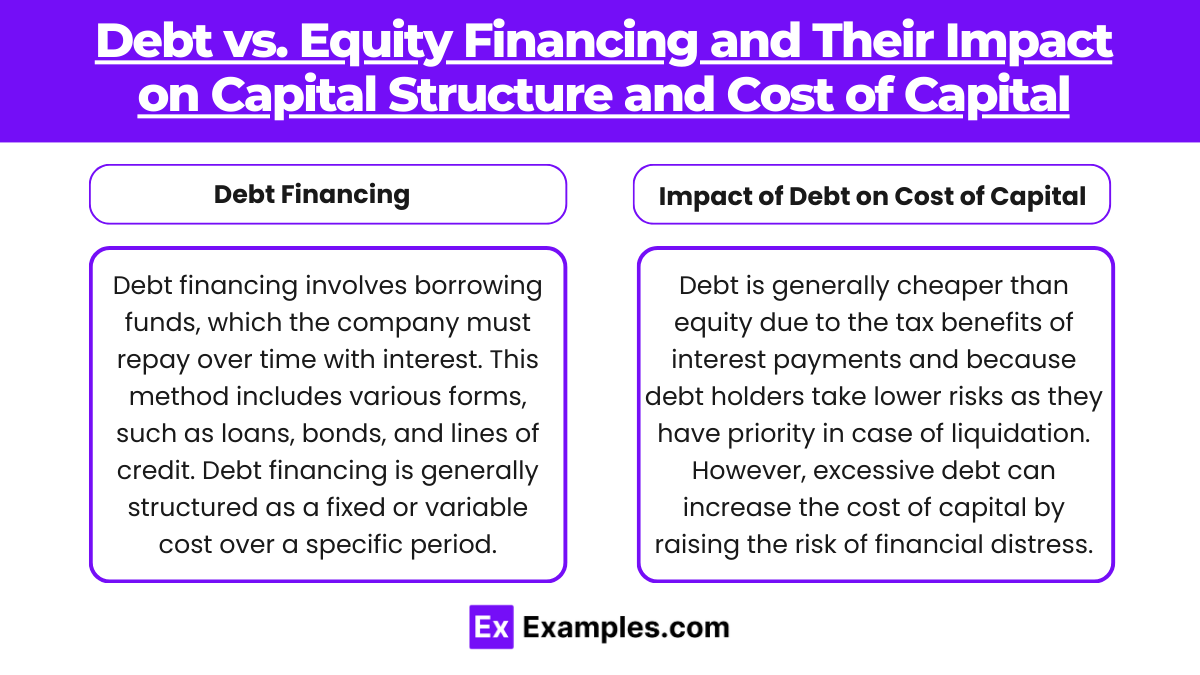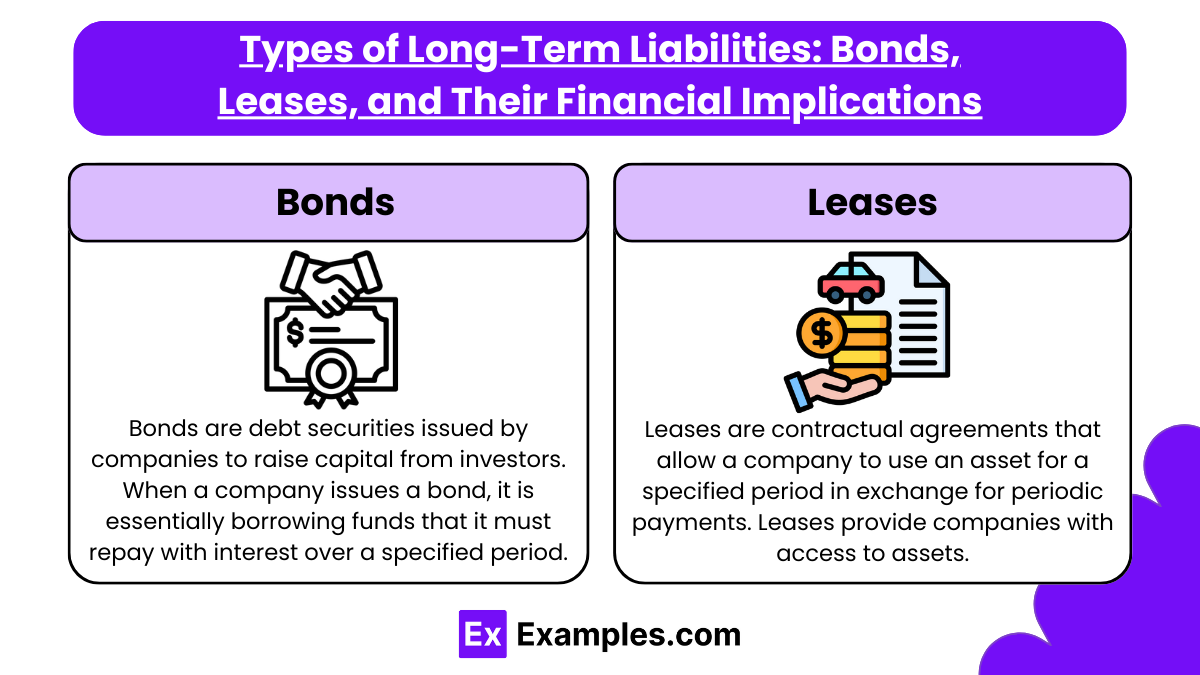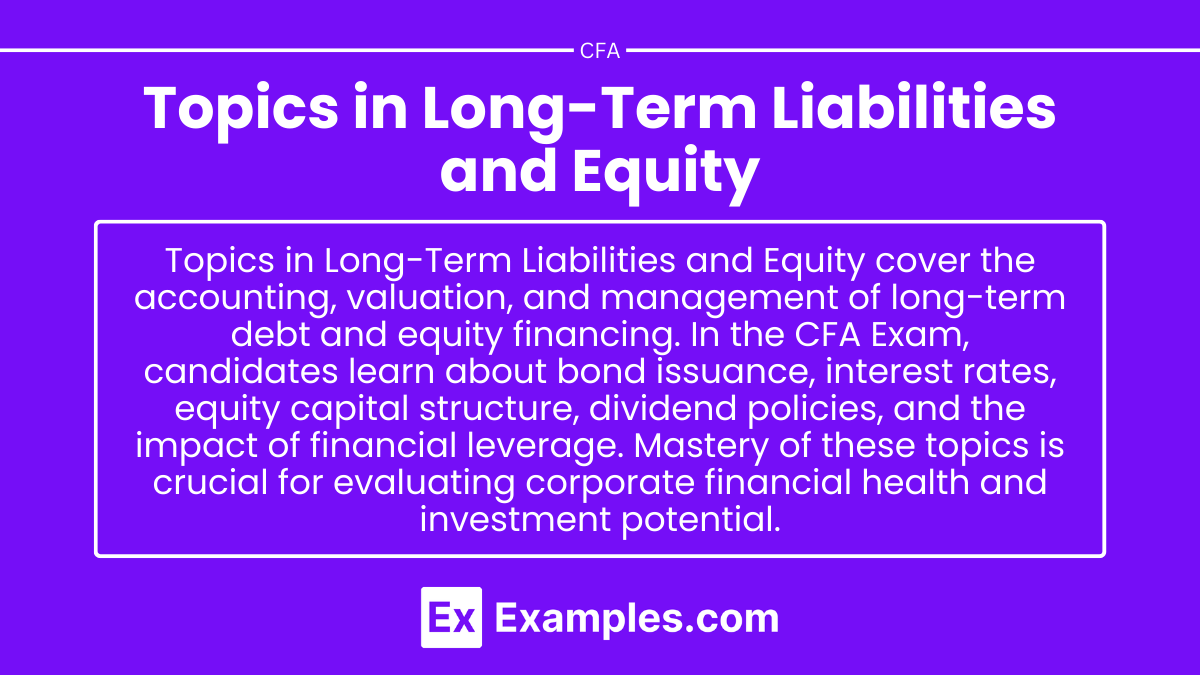Topics in Long-Term Liabilities and Equity encompass essential concepts in financial analysis, focusing on the structure, valuation, and implications of a firm’s capital. This topic explores debt instruments, lease obligations, and bonds, alongside shareholder equity, preferred stock, and retained earnings. Key areas include understanding how long-term liabilities impact a firm’s risk profile and financial performance, as well as how equity components reflect ownership claims. Mastery of these concepts is crucial for evaluating a company’s financial stability, capital structure, and long-term growth potential, forming a foundation for effective financial analysis and decision-making.
Learning Objectives
In studying “Topics in Long-Term Liabilities and Equity” for the CFA, you should learn to analyze the structure, classification, and financial implications of long-term liabilities and equity instruments. Understand the differences between debt and equity financing, and evaluate the impact of each on a company’s capital structure and cost of capital. Assess various types of long-term liabilities, such as bonds and leases, including their valuation, amortization, and impact on financial statements. Analyze shareholders’ equity components, including common and preferred stock, retained earnings, and dividends. Additionally, develop proficiency in understanding the effects of long-term liabilities and equity decisions on financial ratios, leverage, and overall financial health, which are essential for effective financial analysis and investment decision-making in a CFA context.
Structure, Classification, and Financial Implications of Long-Term Liabilities and Equity Instruments

Long-term liabilities and equity instruments play a crucial role in a company’s capital structure, impacting its financial stability, flexibility, and overall risk profile. Understanding the classification and financial implications of these components helps stakeholders assess the company’s financial position and decision-making around financing.
1. Structure and Classification of Long-Term Liabilities
Long-term liabilities are financial obligations that a company must settle over a period extending beyond one year. These obligations impact the company’s liquidity, leverage, and risk, and are a critical component of capital structure.
Types of Long-Term Liabilities
- Bonds Payable: Bonds are debt securities issued by a company to raise capital from investors. Bonds often have fixed interest rates, regular interest payments, and a fixed maturity date.
- Long-Term Loans: Loans provided by banks or financial institutions with repayment terms longer than one year. Long-term loans typically include interest payments and may require collateral or covenants.
- Lease Obligations: Long-term leases, particularly finance leases, are recorded as liabilities if the company has control over the leased asset. Lease liabilities include periodic payments over the lease term.
- Pension and Post-Retirement Obligations: Liabilities representing future payments to employees for pensions, retirement benefits, or health care. These are often accrued over time and can be substantial for companies with defined benefit plans.
- Deferred Tax Liabilities: Amounts owed to tax authorities due to timing differences between tax and accounting treatments. Deferred tax liabilities arise when tax payments are postponed to future periods.
Classification Considerations
- Fixed vs. Variable Interest: Liabilities with fixed interest rates provide stability but may limit flexibility in changing market conditions. Variable interest liabilities, however, can fluctuate with market rates, affecting interest expenses.
- Secured vs. Unsecured: Secured liabilities are backed by collateral, reducing risk for lenders but potentially limiting the company’s use of assets. Unsecured liabilities do not have specific assets backing them, resulting in higher interest costs.
- Convertible Debt: Some debt instruments, like convertible bonds, can be converted into equity at the option of the holder, impacting the equity structure and offering potential for dilution.
2. Structure and Classification of Equity Instruments
Equity instruments represent ownership in a company and are a primary source of permanent capital. Unlike liabilities, equity does not require repayment, but it dilutes ownership and may involve profit sharing through dividends.
Types of Equity Instruments
- Common Stock: The primary ownership stake in a company, entitling holders to voting rights and dividends (if declared). Common stockholders have residual claims on assets after all liabilities are paid.
- Preferred Stock: Hybrid securities with characteristics of both debt and equity. Preferred stockholders usually receive fixed dividends and have priority over common shareholders in asset claims but often lack voting rights.
- Retained Earnings: Profits retained within the company and reinvested rather than distributed as dividends. Retained earnings are a key source of internal financing and reflect accumulated profit over time.
- Treasury Stock: Shares that a company repurchases from the open market. Treasury stock reduces outstanding shares and may be reissued or retired, impacting ownership structure.
- Convertible Preferred Stock: Preferred shares that can be converted into common stock, providing potential equity growth while offering a priority claim on assets and dividends.
Classification Considerations
- Voting Rights: Common stockholders generally have voting rights, giving them a say in major company decisions, while preferred stockholders typically do not.
- Dividend Policy: Preferred stocks often have fixed dividends, making them attractive for income-focused investors, while common stock dividends are variable and discretionary.
- Convertible Features: Convertible instruments can impact ownership and control by converting debt or preferred shares into common equity, potentially diluting existing shareholders.
3. Financial Implications of Long-Term Liabilities
Long-term liabilities affect a company’s financial position in several ways, influencing its cost of capital, cash flow, and risk.
Key Financial Implications
- Interest Expense: Debt obligations involve regular interest payments, which are tax-deductible but increase fixed costs. Rising interest rates or high debt levels can strain cash flow.
- Leverage and Risk: Higher debt increases financial leverage, which can amplify returns when business is good but increases financial risk in downturns. Excessive leverage can lead to financial distress or default risk.
- Tax Benefits: Interest on debt is tax-deductible, reducing the effective cost of borrowing and making debt an attractive financing option in high-tax environments.
- Impact on Cash Flow: Long-term liabilities require regular interest and principal payments, impacting cash flow. This can limit flexibility for reinvestment or expansion, particularly in cash-intensive industries.
- Covenants and Restrictions: Loan agreements often include covenants that restrict certain actions (e.g., additional borrowing or dividend payments), limiting operational flexibility.
Example: A manufacturing company may take on long-term debt to finance new facilities. While this may reduce its tax liability due to interest deductions, it also increases its fixed obligations, adding financial risk if demand slows.
4. Equity financing has distinct financial implications, particularly regarding ownership, profitability, and cost of capital.
Key Financial Implications
- Dilution of Ownership: Issuing new shares dilutes existing shareholders’ ownership percentage, potentially impacting control and decision-making.
- Dividend Obligations: While dividends are not obligatory, companies often pay dividends to attract investors. Paying dividends impacts cash flow, but unlike debt, dividends can be adjusted based on performance.
- Cost of Capital: Equity is generally more expensive than debt because shareholders expect higher returns due to the lack of guaranteed payments and residual claim. This increases the company’s overall cost of capital.
- Financial Flexibility: Equity financing does not involve fixed repayment obligations, providing more flexibility in managing cash flows. This can be particularly advantageous in industries with fluctuating revenues.
- Impact on Return on Equity (ROE): Increasing equity can reduce ROE if profit growth does not keep pace with equity growth, potentially reducing investor appeal.
Example: A technology startup may issue common stock to raise capital for R&D without adding to debt obligations. While this provides flexibility, it also dilutes ownership and potentially lowers ROE if profits do not rise proportionally.
Debt vs. Equity Financing and Their Impact on Capital Structure and Cost of Capital

1. Debt Financing
Debt financing involves borrowing funds, which the company must repay over time with interest. This method includes various forms, such as loans, bonds, and lines of credit. Debt financing is generally structured as a fixed or variable cost over a specific period.
Key Characteristics of Debt Financing
- Fixed Obligations: Debt requires regular interest payments and principal repayment, which creates a fixed financial obligation, impacting cash flow.
- Tax Deductibility: Interest payments on debt are tax-deductible, providing a tax shield that reduces the company’s effective tax rate.
- No Ownership Dilution: Unlike equity, debt does not dilute ownership, allowing original shareholders to retain control over the company.
- Increased Financial Leverage: Debt increases a company’s financial leverage, magnifying both potential returns and risks.
Impact of Debt on Capital Structure
Debt financing increases the proportion of debt relative to equity, known as financial leverage. Higher leverage can enhance shareholder returns when the company performs well, but it also increases financial risk if revenues decline.
- Capital Structure: In industries with stable cash flows, companies may take on higher debt levels to leverage the tax benefits, resulting in a debt-heavy capital structure.
- Debt Ratios: Metrics like the debt-to-equity ratio and debt ratio indicate the level of leverage in the capital structure, impacting the company’s overall risk profile.
Impact of Debt on Cost of Capital
Debt is generally cheaper than equity due to the tax benefits of interest payments and because debt holders take lower risks as they have priority in case of liquidation. However, excessive debt can increase the cost of capital by raising the risk of financial distress.
- Lower Cost of Capital: Moderate use of debt reduces the company’s overall weighted average cost of capital (WACC), as debt is less expensive than equity.
- Risk Premium: As debt levels increase, lenders may require higher interest rates to compensate for additional risk, eventually raising the company’s WACC if leverage becomes too high.
- Optimal Debt Level: The cost of capital is minimized at an optimal debt level, balancing the tax benefits of debt with the potential risks of financial distress.
Example: A utility company with steady cash flows may rely heavily on debt financing to benefit from tax deductions, lowering its WACC and enhancing shareholder returns.
2. Equity Financing
Equity financing involves raising capital by issuing shares of stock. This form of financing does not require repayment or interest payments, as shareholders assume part ownership in the company and share in its profits or losses.
Key Characteristics of Equity Financing
- Ownership Dilution: Issuing new equity dilutes the ownership percentage of existing shareholders, potentially reducing their control over the company.
- Variable Returns: Equity does not come with fixed payments, but shareholders expect dividends or capital gains, depending on company performance.
- Higher Cost than Debt: Equity is generally more expensive than debt because shareholders bear higher risks, as they are paid after all debt obligations.
- Flexibility in Cash Flow: Equity financing does not create fixed obligations, allowing companies more flexibility in managing cash flow.
Impact of Equity on Capital Structure
Equity financing increases the proportion of equity relative to debt in the capital structure, reducing financial leverage and overall financial risk.
- Capital Structure: Companies in high-growth industries or with volatile cash flows often favor an equity-heavy capital structure to avoid the fixed obligations of debt.
- Equity Ratios: Ratios such as the equity ratio and debt-to-equity ratio indicate the balance of equity in the capital structure, impacting financial stability and risk tolerance.
Impact of Equity on Cost of Capital
Equity financing generally raises the company’s WACC, as equity investors expect a higher return on their investment due to the absence of fixed payments and the residual nature of equity claims.
- Higher Cost of Capital: Equity is more costly than debt because it lacks tax deductibility, and shareholders require compensation for taking on more risk.
- Reduced Financial Risk: Despite the higher cost, an equity-heavy structure lowers financial risk, potentially enhancing the company’s ability to invest in long-term projects without the burden of debt repayments.
- Impact on Return on Equity (ROE): Issuing more equity can reduce ROE if profit growth does not keep up with equity growth, potentially making the stock less attractive to investors.
Example: A biotechnology firm in the early stages of development may rely on equity financing to fund R&D. This reduces the financial strain of fixed obligations, allowing the company to focus on growth rather than meeting debt payments.
Types of Long-Term Liabilities: Bonds, Leases, and Their Financial Implications

1. Bonds
Bonds are debt securities issued by companies to raise capital from investors. When a company issues a bond, it is essentially borrowing funds that it must repay with interest over a specified period. Bonds come in various forms, with different structures and risk levels, tailored to meet the financing needs of the company and the investment preferences of bondholders.
Types of Bonds
- Corporate Bonds: Bonds issued by corporations to finance long-term projects, expansion, or operations. They typically carry higher yields than government bonds to compensate for higher risk.
- Convertible Bonds: Bonds that can be converted into a predetermined number of the issuing company’s shares at the option of the bondholder, providing both debt and equity features.
- Callable Bonds: Bonds that the issuer can redeem (or “call”) before the maturity date, often at a premium. This option allows companies to refinance if interest rates decline.
- Secured Bonds: Bonds backed by specific assets, offering greater security to investors in case of default. If the issuer fails to make payments, bondholders have a claim on the collateral.
- Unsecured Bonds (Debentures): Bonds not backed by specific collateral, relying on the issuer’s creditworthiness. These carry a higher risk, typically with higher interest rates to attract investors.
Financial Implications of Bonds
- Interest Expense and Cash Flow Impact: Bonds require regular interest payments, affecting cash flow. While these payments are tax-deductible, they represent a fixed obligation that can strain cash flow, especially if cash reserves are limited.
- Impact on Leverage: Issuing bonds increases financial leverage, as debt raises the debt-to-equity ratio. Higher leverage amplifies both potential returns and financial risk, making bonds a strategic choice for companies with stable cash flows but higher risk for companies with uncertain revenue.
- Cost of Debt and WACC: Bonds are generally a lower-cost option than equity due to the tax deductibility of interest. By incorporating bonds into the capital structure, a company may reduce its overall weighted average cost of capital (WACC), depending on its tax bracket and debt capacity.
- Credit Rating Influence: Issuing bonds can impact a company’s credit rating, depending on the level of debt and the company’s capacity to service it. Higher debt levels may lower the rating, increasing future borrowing costs, while a favorable rating can help secure funding at lower rates.
- Refinancing Risk: Callable bonds allow companies to refinance at lower rates if interest rates decline, but this flexibility can increase the company’s future financial obligations. Conversely, if rates rise, the company may face higher refinancing costs.
Example: A large manufacturing firm may issue secured bonds to finance a new production facility. The interest payments are tax-deductible, lowering the firm’s cost of debt, but the company must ensure stable cash flows to meet its interest obligations.
2. Leases
Leases are contractual agreements that allow a company to use an asset for a specified period in exchange for periodic payments. Leases provide companies with access to assets without the need for upfront capital, making them a flexible alternative to outright purchasing.
Types of Leases
- Finance (Capital) Leases: A lease that transfers the risks and rewards of ownership to the lessee. In accounting, a finance lease is treated as an asset and liability on the balance sheet, and the lessee recognizes depreciation and interest expenses.
- Operating Leases: A lease in which the lessor retains ownership of the asset, and the lessee uses it without showing the asset on its balance sheet. Operating leases are treated as rental expenses on the income statement and offer more flexibility.
- Sale and Leaseback: A transaction where a company sells an asset and then leases it back, allowing the company to free up capital while continuing to use the asset. This arrangement is often used to improve liquidity.
Financial Implications of Bonds
- Balance Sheet Impact: Under recent accounting standards (IFRS 16 and ASC 842), most leases are now capitalized, meaning they appear on the balance sheet as both assets and liabilities. This increases total assets and total liabilities, affecting ratios such as return on assets (ROA) and debt-to-equity.
- Cash Flow Flexibility: Leases, particularly operating leases, reduce upfront capital requirements, preserving cash for other investments. Lease payments are predictable and spread over time, providing budgeting certainty and cash flow flexibility.
- Impact on Leverage and Debt Ratios: Finance leases increase leverage, as they are treated as debt on the balance sheet. This impacts financial metrics like the debt-to-equity ratio and may affect borrowing capacity, similar to traditional debt obligations.
- Tax Implications: For finance leases, depreciation and interest expenses are tax-deductible, similar to debt financing, providing a tax benefit. Operating leases, in contrast, are fully tax-deductible as rental expenses, affecting net income differently.
- Ownership and Asset Risk: Leases allow companies to access and use assets without ownership risks, such as obsolescence or maintenance costs. For assets that depreciate quickly or become obsolete, leasing may be more cost-effective than purchasing.
Example: A retail chain may use operating leases to expand its store network without the upfront capital costs of purchasing real estate. This allows for flexibility to scale up or down as market conditions change, while keeping the assets off the balance sheet.
Shareholders’ Equity Components: Common Stock, Preferred Stock, Retained Earnings, and Dividends

Shareholders’ equity represents the ownership interest in a company and is a critical component of the balance sheet. It includes funds invested by shareholders, earnings retained by the company, and dividends distributed to shareholders. Understanding the components of shareholders’ equity provides insight into the financial structure, funding sources, and distribution policies of a company. Key components of shareholders’ equity include common stock, preferred stock, retained earnings, and dividends.
- Common Stock: Common stock represents the primary ownership interest in a company. When a company issues common stock, it raises capital by offering shareholders partial ownership, voting rights, and a claim on the company’s residual assets after liabilities and preferred stock obligations are settled.
- Preferred Stock: Preferred stock is a hybrid security with characteristics of both equity and debt. It offers investors a fixed dividend payment and priority over common shareholders in asset claims but often lacks voting rights. Preferred stock is commonly used by companies looking to raise capital without diluting voting power.
- Retained Earnings: Retained earnings are the accumulated profits that a company has chosen to reinvest in the business rather than distribute to shareholders as dividends. Retained earnings are a key source of internal financing, supporting activities like expansion, debt reduction, and R&D.
- Dividends: Dividends are payments made to shareholders as a distribution of a company’s earnings. Dividends can be in the form of cash or additional shares of stock, providing shareholders with a return on their investment. The dividend policy reflects the company’s approach to balancing growth with shareholder returns.
Examples
Example 1: Bonds Payable
Bonds are a common form of long-term liability where a company borrows money from investors and agrees to pay back the principal amount at a specified future date, along with periodic interest payments. The accounting for bonds payable involves recognizing the liability on the balance sheet and understanding the implications of different bond structures, such as callable bonds, convertible bonds, and the effect of market interest rates on bond pricing.
Example 2: Leases and Lease Obligations
Long-term liabilities can also include lease obligations resulting from operating and finance leases. Under accounting standards, companies must recognize lease liabilities on their balance sheets, reflecting the present value of future lease payments. Understanding the differences between operating and finance leases, as well as the implications for cash flow and financial ratios, is critical in assessing a company’s long-term obligations.
Example 3: Deferred Tax Liabilities
These are long-term liabilities that arise from differences between accounting income and taxable income, leading to taxes owed in the future. For instance, when a company uses different methods for reporting income for tax purposes and financial reporting, it can create a deferred tax liability. This topic involves understanding how timing differences affect tax obligations and the importance of recognizing these liabilities in financial statements.
Example 4: Equity Financing and Shareholder Equity
Equity financing involves raising capital by issuing shares of stock. Topics in this area include common stock, preferred stock, and additional paid-in capital. Understanding how equity financing affects a company’s capital structure, the rights of shareholders, and the implications for dividend distribution is crucial for financial analysis. This also includes the effects of share buybacks and stock splits on shareholder equity.
Example 5: Covenants Associated with Long-Term Debt
Many companies issue long-term debt with specific covenants or conditions attached. These covenants may restrict certain business activities, such as taking on additional debt, making significant capital expenditures, or paying dividends. Understanding the implications of these covenants is essential for financial analysts, as they can significantly affect a company’s financial flexibility and operational decisions, as well as the overall risk profile of the debt.
Practice Questions
Question 1
Which of the following is a characteristic of bonds payable?
A) They represent ownership in the company.
B) They typically require periodic interest payments.
C) They have no maturity date.
D) They are considered short-term liabilities.
Correct Answer: B) They typically require periodic interest payments.
Explanation: Bonds payable are a form of long-term liability where a company borrows money from investors, promising to pay back the principal amount at maturity along with periodic interest payments, usually semi-annually. Option A is incorrect because bonds do not represent ownership; that is the role of equity securities such as stocks. Option C is false since bonds have a specified maturity date, and option D is incorrect as bonds are classified as long-term liabilities.
Question 2
What is a deferred tax liability?
A) A tax that has been paid but not yet recognized as an expense.
B) A tax that will be paid in the future due to timing differences.
C) A tax that is never paid.
D) A tax credit available to the company.
Correct Answer: B) A tax that will be paid in the future due to timing differences.
Explanation: A deferred tax liability arises when there are temporary differences between the accounting treatment of certain items and their tax treatment. This means that the company will owe taxes in the future based on the income that has been recognized in the financial statements but not yet taxed. Option A refers to an expense recognition issue, option C incorrectly suggests that the tax is never paid, and option D describes a tax benefit rather than a liability.
Question 3
Which of the following best describes a covenant in the context of long-term debt?
A) A legal requirement to pay dividends.
B) An agreement that restricts certain business activities.
C) A guarantee of loan repayment by a third party.
D) A method to convert debt into equity.
Correct Answer: B) An agreement that restricts certain business activities.
Explanation: A covenant is a condition placed on a borrower by a lender to limit certain actions of the borrower to reduce risk. These can include restrictions on additional borrowing, asset sales, or dividend payments. The purpose is to protect the lender’s interests. Option A is incorrect because covenants do not inherently require dividend payments. Option C describes a guarantee, which is different from a covenant. Option D refers to convertible debt, which is not the definition of a covenant.


